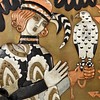circa 1840, dual hammers, double set trigger, "A. Bechtler/N. Carolina" in gold inlay, badge with "W.A.M." and series of hash marks, barrel 24-3/4 in., overall 43 in. - Note: The Bechtler family emigrated to the United States in 1829 from Baden, Germany, an area long known for producing skilled craftsmen in the fields of jewelry and watchmaking. The nearby town of Pforzheim has been referred to as 'goldstadt,' or the golden city. Once in the U.S., the Bechtlers settled in Rutherfordton, North Carolina. The elder of the family, Christopher, began to advertise the service of coining from gold dust and nugget. Over the next decade he would create a reputation of honest coinage and accurate assay for himself and his family. The responsibilities of this coining production were shouldered by Christopher's sons, Christopher Jr. and Augustus. The latter also proved himself to be quite proficient in the art of gunsmithing. A few patents were applied for by the Bechtler family, one for a repeating firearm capable of firing an unheard of eight rounds per minute. An article published in March of 1930 in The American Rifleman references a time when the older generation could remember Bechtler rifles trading hands as the revered heirlooms that they certainly were. However, the article goes on to mention that none were currently known to exist. They had seemingly vanished from existence.In 2016, a Bechtler firearm with rifling to the barrels surfaced and was ceremoniously acquired by the Bechtler House in Rutherfordton, North Carolina. The shotgun being offered here marks only the second known surviving long gun to bear the Bechtler name. It does not have rifling to the barrels as the other does, though both are similar in style and appearance. This shotgun, almost certainly made as a fowling piece, has dual percussion hammers as well as a double set of triggers. Aesthetically there is an elegance seen throughout the instrument. "A. Bechtler" and "N. Carolina" delicately adorn the top of the dual barrels in gold inlay (likely 20 to 22 carat as that was the consistent fineness for their gold).Upon further inspection the viewer notices a fluid, almost aquatic theme, coming to life in the piece. A curlique swirl on the stock resembles a wave. The trigger guard inverted looks to be the head of a dolphin or fish. Checkering is not found at the grip, but in its place are tiny "scales" in the wood. Is it possible some homage was being paid to their homeland of Pforzheim which sees the confluence of the Nagold and Enz Rivers?There is some chance that this could be Augustus' personal firearm made for his own use. He was known to enjoy the sport of hunting and his name is prominently displayed in gold on the barrels. English naturalist, George William Featherstonhaugh, told of a visit to Bechtler's workshop in which he had a customized firearm similarly decorated. Featherstonhaugh wrote, "Mr. Bechtler, having inlaid my name on a rifle with native gold. I paid him for it and took hearty leave..." This form of personalization seems to have been a common practice. Literature: Kephart, Horace. “The Bechtler Rifles.” The American Rifleman LXXVIII, no. 3 (March 1930). - Provenance: A Prominent Virginia Family
Condition
chips to trigger guard, ramrod with splintered damage to concealed end, right hand side some separation between furniture and wood, minor abrasions commensurate with age and period usage, some absent inlay at lettering "A. Bechtler/N. Carolina"
































